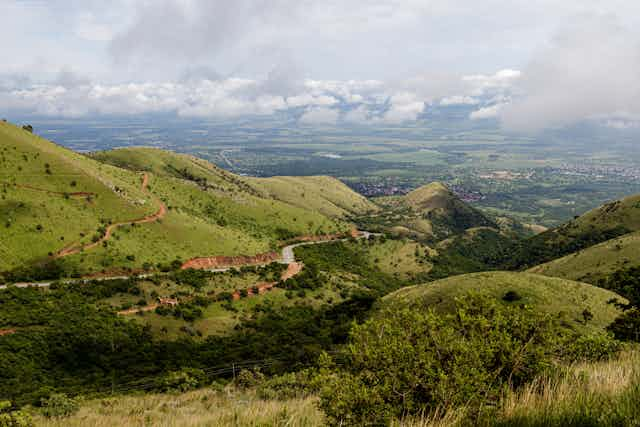Our Earth is around 4.5 billion years old. Way back in its earliest years, vast oceans dominated. There were frequent volcanic eruptions and, because there was no free oxygen in the atmosphere, there was no ozone layer. It was a dynamic and evolving planet.
Scientists know all of this – but, of course, there are still gaps in our knowledge. For instance, while we know what kind of rocks were being formed on different parts of the planet 3.5 billion years ago, we are still understanding which geological processes drove these formations.
Luckily the answers to such questions are available. Evidence is preserved in ancient volcanic and sedimentary rocks dating back to the Archaean age, between 4 billion and 2.5 billion years ago.
These rocks are found in the oldest parts of what are today the continents, called cratons. Cratons are pieces of ancient continents that formed billions of years ago. Studying them offers a window into how processes within and on the surface of Earth operated in the past. They host a variety of different groups of rocks, including greenstones and granites.
One example is the Singhbhum Craton, in the Daitari Greenstone Belt in the state of Odisha in eastern India. This ancient part of the Earth’s crust has been found in previous research to date back to 3.5 billion years ago. The craton’s oldest rock assemblages are largely volcanic and sedimentary rocks also known as greenstone successions. Greenstones are rock assemblages made up mostly of sub-marine volcanic rocks with minor sedimentary rocks.
My research team and I recently published a study in which we compared the Singhbhum Craton to cratons in South Africa and Australia. We chose these sites because they preserve the same kinds of rocks, in the same condition (not intensely deformed or metamorphosed), from the same time period – about 3.5 billion years ago. They are the best archives to study early Earth surface processes.
Our key findings were that explosive-style volcanic eruptions were common in what are today India, South Africa and Australia around 3.5 billion years ago. These eruptions mostly occurred under oceans, though sometimes above them.
Understanding these early Earth processes is vital for piecing together the planet’s evolutionary history and the conditions that may have sustained life during different geological epochs. This kind of research is also a reminder of the ancient geological wonders that surround us – and that there is much more to discover to understand the story of our planet.
The research
We sampled some rocks from the Singhbhum Craton so we could study them in our laboratory. Existing data from the same site, as well as sites in South Africa and India, were used for comparison purposes.
Our detailed field-based studies were complemented by uranium-lead (U-Pb) radiometric-age dating. This common and well-established method provides information as to when a magma crystallised; in other words, it tells us when a rock formed. In this way we were able to establish key geological timelines to illustrate what processes were underway and when.
Read more: Why the discovery of a small continental fragment in the Indian Ocean matters
We also found that the geology of this area shares stark similarities with the greenstone belts documented in South Africa’s Barberton and Nondweni areas and the Pilbara Craton in western Australia.
Most particularly, all these areas experienced widespread submarine mafic – meaning high in magnesium oxide – volcanic eruptions between 3.5 and 3.3 billion years ago, preserved as pillowed lava and komatiites.
This differs from silicic (elevated concentration of silicon dioxide) volcanism, which research has shown was prevalent around 3.5 billion years ago.
These findings enrich our understanding of ancient volcanic and sedimentary processes and their significance in the broader context of Earth’s geological as well as biological evolution.
Our planet’s formative years
Our discoveries are pivotal for several reasons. First, they offer a clearer picture of Earth’s early tectonic activities during the Archaean times, contributing to our understanding of the planet’s formative years.
Read more: Four ways that fossils are part of everyday life
Second, the Singhbhum Craton’s unique geological features, including its greenstone belts, provide invaluable information about Earth’s surface and atmospheric processes. This is crucial for hypothesising early habitable conditions and the emergence of life on Earth.
Additionally, comparing the Singhbhum Craton with similar cratons in South Africa and Australia allows us to construct a more comprehensive model related to geological processes that operated during the Archaean. This can help to shed light on ancient geodynamic processes that were prevalent across different parts of the young Earth.
This research emphasises the need for further exploration into the geological history of ancient cratons worldwide. Understanding these early Earth processes is vital for piecing together the planet’s evolutionary history and the conditions that may have sustained life.

